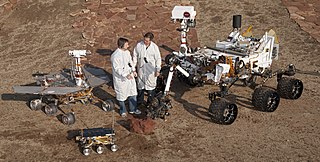The Mars program was a series of uncrewed spacecraft launched by the Soviet Union between 1960 and 1973. The spacecraft were intended to explore Mars, and included flyby probes, landers and orbiters.

A lander is a spacecraft that descends towards, comes to rest on, the surface of an astronomical body. In contrast to an impact probe, which makes a hard landing that damages or destroys the probe upon reaching the surface, a lander makes a soft landing after which the probe remains functional.

The planet Mars has been explored remotely by spacecraft. Probes sent from Earth, beginning in the late 20th century, have yielded a large increase in knowledge about the Martian system, focused primarily on understanding its geology and habitability potential. Engineering interplanetary journeys is complicated and the exploration of Mars has experienced a high failure rate, especially the early attempts. Roughly sixty percent of all spacecraft destined for Mars failed before completing their missions and some failed before their observations could begin. Some missions have met with unexpected success, such as the twin Mars Exploration Rovers, Spirit and Opportunity which operated for years beyond their specification.

Sleepers of Mars is a collection of early short stories by British writer John Wyndham, published after his death, in 1973 by Coronet Books.

Colonization or settlement of Mars is the theoretical human migration and long-term human establishment of Mars. The prospect has garnered interest from public space agencies and private corporations and has been extensively explored in science fiction writing, film, and art.

Space Odyssey: Voyage to the Planets, marketed as Voyage to the Planets and Beyond in the United States, is a 2004 two-part fictional documentary created by Impossible Pictures and produced by BBC Worldwide, Discovery Communications and ProSieben. Space Odyssey chronicles a fictional crewed voyage throughout the Solar System, which is used to convey scientific information on spaceflight and on the different planets. The programme was initially announced under the title Walking with Spacemen as an instalment in the Walking with... franchise of documentaries. Though the title was changed before release and its connection to the other Walking with... programmes was removed, it was broadcast under the original title in Canada. The special effects and scientific accuracy of Space Odyssey was praised by critics, though some criticism was leveled at the storylines and drama portions of the programme.

The MARS-500 mission was a psychosocial isolation experiment conducted between 2007 and 2011 by Russia, the European Space Agency, and China, in preparation for an unspecified future crewed spaceflight to the planet Mars. The experiment's facility was located at the Russian Academy of Sciences' Institute of Biomedical Problems (IBMP) in Moscow, Russia.

The Martian Chronicles is a 1980 television three-episode miniseries based on Ray Bradbury's 1950 book The Martian Chronicles and dealing with the exploration of Mars and the inhabitants there. The series starred Rock Hudson, Darren McGavin, Bernadette Peters, Roddy McDowall, Fritz Weaver, Barry Morse, and Maria Schell. It was aired on NBC in January 1980 in three episodes with a total running time of just over four hours. The series depicts Mars as having a "thin atmosphere" which humans can breathe, with water-filled canals and desert-like vegetation. The miniseries was directed by Michael Anderson and written by Richard Matheson.

The following outline is provided as an overview of and topical guide to space exploration.

A rover is a planetary surface exploration device designed to move across the solid surface on a planet or other planetary mass celestial bodies. Some rovers have been designed as land vehicles to transport members of a human spaceflight crew; others have been partially or fully autonomous robots. Rovers are typically created to land on another planet via a lander-style spacecraft, tasked to collect information about the terrain, and to take crust samples such as dust, soil, rocks, and even liquids. They are essential tools in space exploration.

The idea of sending humans to Mars has been the subject of aerospace engineering and scientific studies since the late 1940s as part of the broader exploration of Mars. Some have also considered exploring the Martian moons of Phobos and Deimos. Long-term proposals have included sending settlers and terraforming the planet. Proposals for human missions to Mars came from e.g. NASA, Russia, Boeing, and SpaceX. As of 2023, only robotic landers and rovers have been on Mars. The farthest humans have been beyond Earth is the Moon.
Lego Mars Mission was a Lego theme sold from 2007 to 2009. It is set on Mars and features astronauts, aliens, and high-tech machinery.

Northern Light was a concept mission for a robotic mission to Mars that would consist of a lander and a rover, being studied by a consortium of Canadian universities, companies and organisations. The primary contractor for the spacecraft was Thoth Technology Inc.

Space architecture is the theory and practice of designing and building inhabited environments in outer space. This mission statement for space architecture was developed at the World Space Congress in Houston in 2002 by members of the Technical Aerospace Architecture Subcommittee of the American Institute of Aeronautics and Astronautics (AIAA). The architectural approach to spacecraft design addresses the total built environment. It is mainly based on the field of engineering, but also involves diverse disciplines such as physiology, psychology, and sociology.
Human outposts are artificially-created, controlled human habitats located in environments inhospitable for humans, such as on the ocean floor, in the Antarctic, in space, or on another planet.

The Martian Moons eXploration (MMX) is a robotic space probe set for launch in 2024 to bring back the first samples from Mars' largest moon Phobos. Developed by the Japanese Aerospace Exploration Agency (JAXA) and announced on 9 June 2015, MMX will land and collect samples from Phobos once or twice, along with conducting Deimos flyby observations and monitoring Mars' climate.

The Planetary Exploration of China, also known as Tianwen, is the robotic interplanetary spaceflight program conducted by the China National Space Administration (CNSA). The program aims to explore planets of the Solar System, starting from Mars, and will be expanded to Jupiter and more in the future.